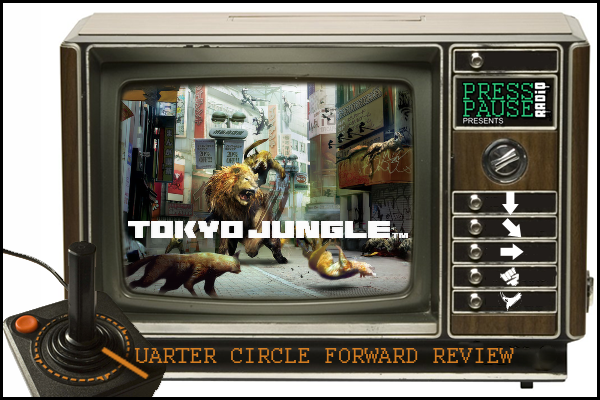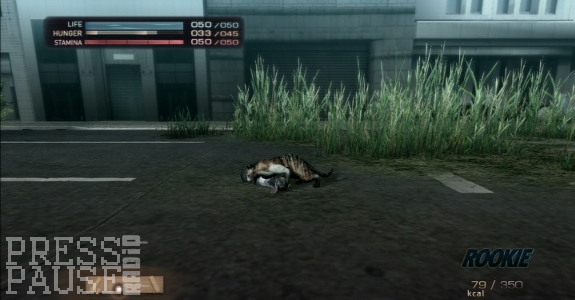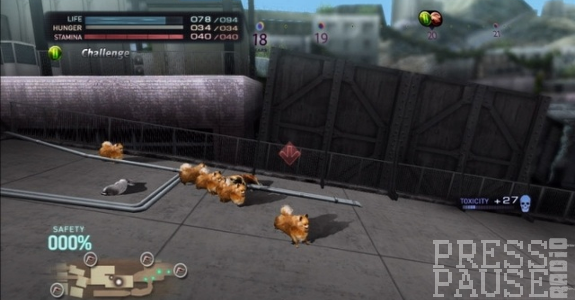QCF: Tokyo jungle

In the seemingly desolate urban ruins of the once established city of Tokyo, a creature emerges. A tiny Pomeranian dog reveals himself out in the open, casting aside his thin veil of secrecy the tall grass in streets of Dogenzaka provided. Grazing in the distance in front of a department store, a lone rabbit is quietly stalked by the Pomeranian, completely unaware of impending doom that lurks upon it. As the Pomeranian readies its strike, a giant lion bursts through the window of the department store and mauls them both into submission. The lion is pleased with his newly acquired meal…until he’s interrupted with a challenge from a pack of chimpanzees and its cleat-wearing leader.
Japan Studio, the second-party Sony developer known for original IPs like Ape Escape and Kung-Fu Rider, teams up with Crispy’s to develop Tokyo Jungle, one of the weirdest and yet charming titles to release this year. Nevertheless, what kind of game is this exactly? Is it a beat’em up? Well, how about a Rouge-like? Try as you might, That’s the charm of this title, Tokyo Jungle is what it is and carries itself unlike any game we’ve seen yet.
 Tokyo Jungle sets into the ambiguous aftermath of some apocalyptic occurrence that wiped out all of humankind, and plays the part for the primitive animal kingdom to rise again. Starting from the main menu, you’re given the opportunity to first play survival and then later a story mode (which is actually just a series of set missions with narrative context attached to the associated animal involved). Survival mode is where the real meat and potatoes are: The animal roster is first step, allowing a selection of either one of the two classes within the game. A predator that preys on other smaller animals to survive, or herbivores that seek out plant life and shelter to survive the harsh conditions of wild Tokyo.
Tokyo Jungle sets into the ambiguous aftermath of some apocalyptic occurrence that wiped out all of humankind, and plays the part for the primitive animal kingdom to rise again. Starting from the main menu, you’re given the opportunity to first play survival and then later a story mode (which is actually just a series of set missions with narrative context attached to the associated animal involved). Survival mode is where the real meat and potatoes are: The animal roster is first step, allowing a selection of either one of the two classes within the game. A predator that preys on other smaller animals to survive, or herbivores that seek out plant life and shelter to survive the harsh conditions of wild Tokyo.
The roster has a meager list of starting animals. You either begin as a Pomeranian dog (the starting predator) or a Sika Deer (the starting herbivore). The vast amount of animals within the catalog is overwhelming; locked silhouettes of other animals litter the screen. The selection and their requirements to unlock them are one of the many layers of the deceptive depth in the core gameplay of Tokyo Jungle that gnaw at the frontal lobes of your brain, making you whisper to yourself, “just one more”
The flow of survival is exactly was the name suggests; you’ll be placed on streets of Shibuya Station (The heart and starting point for every play through of Survival), living as long as you can against the clocks and fighting against the elements, primarily to fulfill the main instinct of any animal -- hunger. Your monitor the status of three bars that determine your odds: The standard health bar, hunger bar, and stamina bar. Hunger is constantly draining and will fluctuate differently based on the class and specific species of animal in your control. Depending on what class you choose, you’ll start scouring the city, section by section, hunting possible leads of food in order to maintain your hunger meter. If it's neglected, you'll starve to death.
Hunting immediately fleshes out the inherent charm of the dystopian Tokyo, and the world itself is one of the finest features of the game to begin with. Each part of Tokyo is divided into a simple yet delightfully complex stage of a larger open world. The expansive nature of the city successfully lifts 2D design elements from River City Ransom liberally, and blends them into this layered intricacy that’s constructed with Rockstar Games-caliber sandbox design. Traveling through a giant video game world hasn’t been this fun in such a long time, and it’s something that’s been missing from modern game design for a while now.
In order to survive, your animal must seek out sustenance by means of reasonable game or stationary foliage. Prey and plant life earn you calories, which act as experience points for leveling up in the order of Rookie, Veteran and Boss. Time flows in an expedient manner, and a few minutes translates into years in Tokyo Jungle. Eventually, mating is required to continue your generation, as old age sets in and takes its toll at the 15 year mark.

In order to mate, you’ll need to conquer territory within your stage of the city until you’ve claimed all of its perimeter through “marking” specified flag spots. Conquering a territory attracts the attention of a prospective mate, and depending on their class and rank, some have requirements in order to court them. Others, however, are more desperate then a scribbled number on the stall of bathroom at your local bar, and even have fleas at times. If it weren’t already obvious, you would be better off avoiding these woeful lovers.
Doing the nasty breeds a new generation of animals. Depending on the pedigree within your choice of mate, as well as your existing rank and stats, the new younglings inherit these improvements. The new generation litter also has you taking control of a pack, which again, adds another significant mechanic to survival that plays an all too important role in successful survival as you race against the clock.
Initially, the flow may seem repetitive. But there are two components that seamlessly change up in every play through in Survival mode, and various rouge-like conditions take place in the world and constantly change. Heavy rain comes into play and hinders both your direct line of sight and marker within your mini-map radar. Pollution plays another large factor that causes a poisoning status condition based on levels of toxicity that that infects both plant life and animals. Random heat-waves, epidemic population growth of a certain animal, and other conditions constantly change. Overall, the experience keeps you anxiously reflecting on what sort of fresh hell you'll step into next. Another spontaneous dynamic includes sets of challenges that cycle through every specific set of perpetuating time frame (or blocks of years).

Challenges include a specific intake of calories (or ranking up). Locating a certain landmark within the city, each challenge rewards you with you with extra stat bonuses to your combat or defensive stats.
Combat is rather simple but effective. You’ll strike with claws or talons overcome your foe. You’re also given the ability to stealth kill by covertly stalking an animal and waiting for a “bite” reticle to line up over your target before it solidifies, signaling a one-shot lethal charge that immediately ends your opponent. As your stats progress, the bite reticle rate is much quicker (this perk is automatically in effect for prey smaller than you). The majority of your stealth kills will take effect under tall grass, which plays a delightfully functional nod to Metal Gear Solid 3 for both hunting and escaping when playing the role of a defensive herbivore.
The innate charm hits home with anyone who gives Tokyo Jungle the chance to hook its claws in you with several different features that are finely woven over the apparent formula of gameplay. Tokyo Jungle also contains items that will help you through consumable use like pet food or medicine that will cure toxicity and hunger and clothing that can be equipped to enhance your animals stats and be whimsical as you find that you’ve clothed a giraffe in rain-boots and baseball cap.
It’s moments like that where you truly appreciate the design in Tokyo Jungle’s presentation. The graphics may not take full advantage of the PlayStation 3 hardware, but the art style and graphics are excecuted within the reach of the game’s intended portrayal. In other Japanese games, you’ll often encounter an emphasis on presentation that’s incredibly obnoxious and redundant with recycled themes or certain aesthetic choices, but Tokyo Jungle knows exactly what it’s trying to convey and embellishes in it in all of the right ways. Music is handled with the same conservative approach through intensive techno-fused tempos and somber instrumentals that fall in line with the title’s attitude.
With decline of interest in modern Japanese developed games, Tokyo Jungle takes an assortment of solid ideas and blends them into an incredibly addictive and quirky charming title that manages to be forward thinking and mindless fun all at the same time. The deceptively deep mechanics you'll uncover through different animals and the rules that intuitively flesh themselves out through play will have you coming back to this game until the end of time. This game should be in the software library of every Playstation 3 owner.

 Japan Studio,
Japan Studio,  PSN,
PSN,  Rouge-like,
Rouge-like,  beat'em ups | in
beat'em ups | in  QCF Reviews
QCF Reviews 









